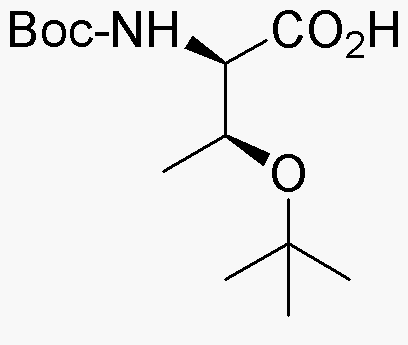Boc-O-tert-butyl-D-threonine is widely utilized in research focused on:
- Peptide Synthesis: This compound serves as a protecting group in the synthesis of peptides, allowing for the selective modification of amino acids without affecting others. This is particularly useful in the pharmaceutical industry for developing new drugs.
- Bioconjugation: It plays a crucial role in bioconjugation processes, where it helps in attaching biomolecules to surfaces or other molecules, enhancing the effectiveness of diagnostic tools and therapeutic agents.
- Protein Engineering: Researchers use it to modify proteins for better stability and functionality, which is essential in biotechnology applications, including enzyme production and vaccine development.
- Drug Development: The compound is involved in the design of novel therapeutic agents, particularly in the development of amino acid derivatives that can target specific biological pathways.
- Research in Chiral Chemistry: Its chiral properties make it valuable in studies focused on asymmetric synthesis, helping chemists create more efficient and selective reactions compared to non-chiral counterparts.
General Information
Properties
Safety and Regulations
Applications
Boc-O-tert-butyl-D-threonine is widely utilized in research focused on:
- Peptide Synthesis: This compound serves as a protecting group in the synthesis of peptides, allowing for the selective modification of amino acids without affecting others. This is particularly useful in the pharmaceutical industry for developing new drugs.
- Bioconjugation: It plays a crucial role in bioconjugation processes, where it helps in attaching biomolecules to surfaces or other molecules, enhancing the effectiveness of diagnostic tools and therapeutic agents.
- Protein Engineering: Researchers use it to modify proteins for better stability and functionality, which is essential in biotechnology applications, including enzyme production and vaccine development.
- Drug Development: The compound is involved in the design of novel therapeutic agents, particularly in the development of amino acid derivatives that can target specific biological pathways.
- Research in Chiral Chemistry: Its chiral properties make it valuable in studies focused on asymmetric synthesis, helping chemists create more efficient and selective reactions compared to non-chiral counterparts.
Documents
Safety Data Sheets (SDS)
The SDS provides comprehensive safety information on handling, storage, and disposal of the product.
Product Specification (PS)
The PS provides a comprehensive breakdown of the product’s properties, including chemical composition, physical state, purity, and storage requirements. It also details acceptable quality ranges and the product's intended applications.
Certificates of Analysis (COA)
Search for Certificates of Analysis (COA) by entering the products Lot Number. Lot and Batch Numbers can be found on a product’s label following the words ‘Lot’ or ‘Batch’.
*Catalog Number
*Lot Number
Certificates Of Origin (COO)
This COO confirms the country where the product was manufactured, and also details the materials and components used in it and whether it is derived from natural, synthetic, or other specific sources. This certificate may be required for customs, trade, and regulatory compliance.
*Catalog Number
*Lot Number
Safety Data Sheets (SDS)
The SDS provides comprehensive safety information on handling, storage, and disposal of the product.
DownloadProduct Specification (PS)
The PS provides a comprehensive breakdown of the product’s properties, including chemical composition, physical state, purity, and storage requirements. It also details acceptable quality ranges and the product's intended applications.
DownloadCertificates of Analysis (COA)
Search for Certificates of Analysis (COA) by entering the products Lot Number. Lot and Batch Numbers can be found on a product’s label following the words ‘Lot’ or ‘Batch’.
*Catalog Number
*Lot Number
Certificates Of Origin (COO)
This COO confirms the country where the product was manufactured, and also details the materials and components used in it and whether it is derived from natural, synthetic, or other specific sources. This certificate may be required for customs, trade, and regulatory compliance.


